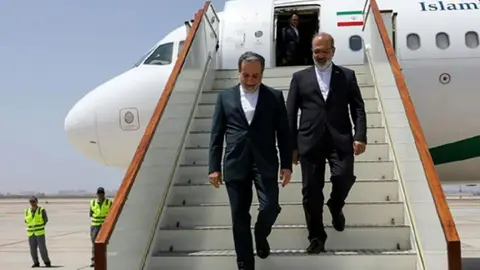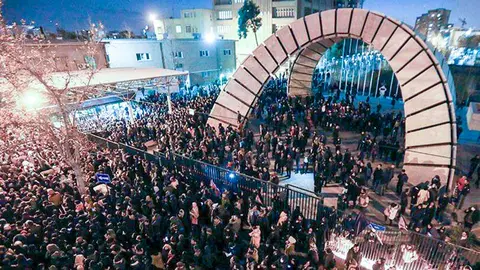Strike in Iran: tens of thousands of truck drivers mobilised in 130 cities across 30 provinces

- The explosion in the port of Bandar Abbas: trigger for the strike
- The strategic importance of the road transport sector
- The impact of the strike on other economic sectors
- Growing support for the strike
- Reaction from the Iranian regime
- ‘A strike orchestrated by hostile foreign media’
- Conclusion
From the morning of Thursday 22 May, drivers from several cities across the country began to join the movement. To date, the strike has spread to 130 cities in 30 provinces.
The explosion in the port of Bandar Abbas: trigger for the strike
A powerful explosion in the port of Bandar Abbas burned a large number of drivers and their trucks. The explosion was caused by the dangerous storage of solid missile propellant (sodium perchlorate) belonging to the Revolutionary Guard, which was stored without any safety measures among ordinary civilian goods. This incident caused heavy human and material losses and angered the population, particularly truck drivers.
The strategic importance of the road transport sector
More than 90% of goods transport in Iran is carried out by this sector. According to available statistics, around 900,000 drivers and more than 400,000 active trucks travel daily throughout the country, transporting millions of tonnes of goods, including fuel, food, and agricultural and industrial products. The Iranian economy is heavily dependent on road transport, making truck drivers one of the most powerful professional groups in the country.
A strike in this sector can have a domino effect, quickly affecting various segments of the economy and potentially leading to significant political pressure.
The impact of the strike on other economic sectors
Food supply chains are already being disrupted, and there are reports of fuel shortages in some regions, particularly in the central province of Markazi.
Main demands of the truck drivers:
- An increase in the price of diesel and the restoration of subsidised fuel quotas, which were previously granted to truck drivers at a preferential price.
- Adjustment of transport tariffs to the rate of inflation.
- Excessive insurance costs.
- The high price of spare parts.
- The elimination of the road transport mafia.
Adel Najafzadeh, an Iranian MP, stated:
‘The national transport fleet is collapsing due to decades of neglect, lack of modernisation and lack of concrete support for road workers.’ (Ham-Mihan newspaper, 26 May 2025)
Growing support for the strike
The mobilisation is gaining ground in various sectors. Farmers, bakers and many citizens directly affected by the prolonged power cuts have expressed their solidarity with the truck drivers.
A video shared on social media shows a banner hanging from a pedestrian bridge in Tehran on Tuesday 27 May, which reads: ‘Brave and united truck drivers, your strikes are rekindling hopes for a national uprising. We are with you until victory.’
This popular support increased the likelihood that the strike would turn into a nationwide protest movement. On 27 May, the number of cities involved rose from 93 to 125, increasing pressure on the regime.
Some describe the movement as a ‘growing economic war’ against systemic corruption and an incompetent government.
Maryam Rajavi, leader of the Iranian Resistance, expressed her full support for the truckers' strike and stated:
‘As long as this regime remains in place, poverty, discrimination and corruption will get worse. The only way forward is through protest and resistance to regain national sovereignty from the Islamic Republic.’
Reaction from the Iranian regime
The Iranian regime has adopted a dual strategy of repression and disinformation. Meanwhile, pro-government media outlets remain silent on the issue. Arrests and beatings have been reported in several cities, including Shiraz and Sanandaj. The regime has threatened to revoke work permits and confiscate trucks. At the same time, security forces were deployed in major transport hubs.
On 25 May, Mohammad Bagher Ghalibaf, Speaker of Parliament, promised ‘immediate attention’ to the drivers' demands. However, the measures proposed, such as a possible increase in the fuel quota, were rejected by the drivers as insufficient. The regime even promised 500 litres of free fuel to those who did not participate in the strike, but the drivers ignored him. In some areas, striking drivers have blocked roads to prevent regime agents from breaking the strike.
The regime's greatest fear is that other professional guilds will join the truck drivers, triggering a general strike.
‘A strike orchestrated by hostile foreign media’
Faced with the spread of the strike, MPs expressed their concern. Mohammadreza Rezaei, chairman of the Urban Development Committee, warned of the consequences:
‘If drivers stop working for a single day, the economic losses will amount to billions of tomans. The country's enemies are lying in wait and are targeting this community of drivers in particular, who play a strategic role in the supply of fuel and goods.’ (Ham-Mihan newspaper - 25 May 2025)
Reza Akbari, deputy minister of transport, has stated:
‘A minority of drivers are trying to cause trouble. These actions are the result of incitement by hostile foreign media outlets that want to make our roads look dangerous.’ (Semi-official ILNA news agency – 25 May 2025)
Conclusion
There are no signs that the strike is running out of steam. The drivers' unions remain mobilised and insist that they will only return to work in exchange for concrete guarantees. Against a backdrop of water shortages and prolonged power cuts, it seems unlikely that the regime will be able to resolve the truckers' grievances. So as long as the root causes of popular anger remain, we can expect to see unrest on the country's political horizon.



